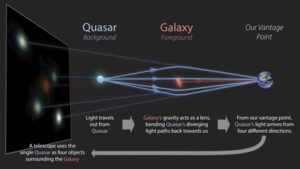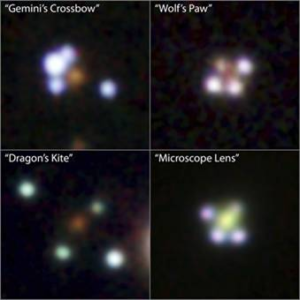Expansion of the Universe
- Expansion of the universe is the increase in distance between any two given gravitationally unbound parts of the observable universe with time.It is an intrinsic expansion whereby the scale of space itself changes. The universe does not expand “into” anything and does not require space to exist “outside” it.
- Technically, neither space nor objects in space move. Instead it is the metric governing the size and geometry of spacetime itself that changes in scale.
- As the spatial part of the universe’s spacetime metric increases in scale, objects move apart from one another at ever-increasing speeds.
- To any observer in the universe, it appears that all of space is expanding while all but the nearest galaxies recede at speeds that are proportional to their distance from the observer – at great enough distances the speeds exceed even the speed of light.
Expansion of the universe and General Relativity
- As an effect of general relativity, the expansion of the universe is different from the expansions and explosions seen in daily life.
- It is a property of the universe as a whole rather than a phenomenon that applies just to one part of the universe and, unlike other expansions and explosions, cannot be observed from “outside” of it.
Expansion of the universe and Big Bang
- Metric expansion is a key feature of Big Bang cosmology, is modeled mathematically with the Friedmann–Lemaître–Robertson–Walker metric and is a generic property of the universe we inhabit.
- However, the model is valid only on large scales (roughly the scale of galaxy clusters and above), because gravity binds matter together strongly enough that metric expansion cannot be observed on a smaller scale at this time.
- As such, the only galaxies receding from one another as a result of metric expansion are those separated by cosmologically relevant scales larger than the length scales associated with the gravitational collapse that are possible in the age of the universe given the matter density and average expansion rate.
Expansion of the universe and Inflation Theory
- According to inflation theory, during the inflationary epoch about 10−32 of a second after the Big Bang, the universe suddenly expanded, and its volume increased by a factor of at least 1078 (an expansion of distance by a factor of at least 1026 in each of the three dimensions), equivalent to expanding an object 1 nanometer (10−9 m, about half the width of a molecule of DNA) in length to one approximately 10.6 light years (about 1017 m or 62 trillion miles) long.
- A much slower and gradual expansion of space continued after this, until at around 9.8 billion years after the Big Bang (4 billion years ago) it began to gradually expand more quickly, and is still doing so.
- Physicists have postulated the existence of dark energy, appearing as a cosmological constant in the simplest gravitational models, as a way to explain this late-time acceleration.
- According to the simplest extrapolation of the currently-favored cosmological model, the Lambda-CDM model, this acceleration becomes more dominant into the future.
- In June 2016, NASA and ESA scientists reported that the universe was found to be expanding 5% to 9% faster than thought earlier, based on studies using the Hubble Space Telescope.
Quadruply imaged quasars discovered can help determine expansion rate of the universe
- A group of astronomers have discovered a dozen quasars that have been warped by a naturally occurring cosmic “lens” and split into four similar images.
- This discovery increases the number of known quasars or quads by about 25 percent .
- The study by Gaia Gravitational Lenses Working Group (GraL) of astronomers, spanning only a year and a half, demonstrates the power of machine-learning to assist astronomers in their search for these cosmic jewels.
- It has been accepted for publication in ‘The Astrophysical Journal’.

Cosmological Dilemma
- In recent years, a discrepancy has emerged over the precise value of the universe’s expansion rate, also known as Hubble-Lemaître’s constant.
- Two primary means can be used to determine this number:
- One relies on measurements of the distance and speed of objects in our local universe.
- Other extrapolates the rate from models based on distant radiation left over from the birth of our universe called the cosmic microwave background.
- The problem is that the numbers do not match. The quasars lie in between the local and distant targets used for the previous calculations.
The new quasar quads, which the team gave nicknames such as “Wolf’s Paw” and “Dragon Kite,” will help in future calculations of Hubble-Lemaître’s constant and may illuminate why the two primary measurements are not in alignment.

Quasars
- Quasars are extremely luminous cores of distant galaxies that are powered by supermassive black holes.
- Quadruply imaged quasars are rare, and the first quadruple image was discovered in 1985.
- Over the past four decades, astronomers have found about fifty of these “quadruply imaged quasars” or quads for short, which occur when the gravity of a massive galaxy that happens to sit in front of a quasar splits its single image into four.
Hubble’s law
- Also known as the Hubble–Lemaître law,is the observation in physical cosmology that galaxies are moving away from the Earth at speeds proportional to their distance.
- In other words, the farther they are the faster they are moving away from Earth. The velocity of the galaxies has been determined by their redshift, a shift of the light they emit toward the red end of the spectrum.
- Hubble’s law is considered the first observational basis for the expansion of the universe, and today it serves as one of the pieces of evidence most often cited in support of the Big Bang model.
- The motion of astronomical objects due solely to this expansion is known as the Hubble flow.
- It is often expressed by the equation v = H0D, with H0 the constant of proportionality—Hubble constant—between the “proper distance” D to a galaxy, which can change over time, unlike the comoving distance, and its speed of separation v, i.e. the derivative of proper distance with respect to cosmological time coordinate.
















